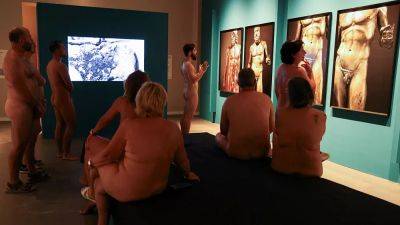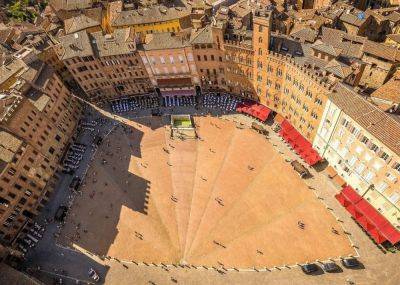Want to watch the sixth and final season of The Crown at an estate that has the royal stamp of approval from the British monarchy? Whether you’re looking to vacation like King Charles III or unwind like Queen Elizabeth II, here are a handful of stunning royalty-approved UK properties that any commoner can book.
A crumbling, long-forgotten statue with an unusual erect phallus might be a Michelangelo. Renaissance scholars want hard evidence.
15.10.2023 - 13:09 / insider.com
Some 400 years ago, Cardinal Ludovico Ludovisi — whose family would produce two popes, more than a dozen cardinals, and a smattering of statesmen — bought what became known as the Villa Aurora from Italy's Orsini family. A sprawling estate on the outskirts of Rome, it included an art collection that drew admirers from across Europe and, most notably, Caravaggio's only ceiling mural.
In a place of honor was a life-size marble statue of the Greek god Pan with a wicked expression, a forked beard, and an 8-inch erect penis leaning left. The cardinal, it appears, built a pillared shrine for it between two majestic cypress trees.
Over the centuries, new research has found, the Ludovisi family's attitude toward the marble god changed. A satyr with an ugly grimace and an imposing phallus? What would the neighbors think?
By 1885, a sculpted fig leaf covering the uncircumcised penis had disappeared. A row of hedges was planted in front of the statue, allowing it to recede out of view.
Sometime in the second half of the 20th century, the hedges were gone and a tree was planted in front of the statue. Artists and scholars continued to copy and study the works of the villa, but the statue left the public record for a century, not drawn or photographed between 1885 and 1985. Pan, the Greek god of woodlands and lust, was left to waste away behind a tree.
When Corey Brennan, a classics professor at Rutgers University, visited the property for the first time, in spring 2010, he didn't know what to do with the statue. The villa's steward at the time, Princess Rita Jenrette Boncompagni Ludovisi, had cleared away the tree a couple of years earlier and brought the sculpture back into public view.
She said the statue was created by Michelangelo Buonarroti, the Renaissance master who painted the Sistine Chapel and etched David out of marble before his 1564 death. She learned this from her husband, Nicolò, who heard it from his grandfather Francesco Boncompagni Ludovisi, whose "depth of historical information, handed down from generation to generation, always is proven to be historically correct and consistent," Princess Rita told Insider.
The statue's provenance was widely accepted by the 1730s, but a group of German scholars in the 19th century had cast doubt on the attribution. When, in July 2022, a student of Brennan's, Hatice Çam, said she was a Michelangelo fanatic, he turned the question over to her.
"See what you can do with it," he recalled telling her.
Çam took on the assignment with relish. Digging into the estate's archives and other historical documents, she found centuries-old private sketches of the statue and correspondences and journal entries describing it.
Over time, the elements had beaten the statue,

Saudi City Neom Spreads Its Cash With Investment Fund
Saudi Arabia’s super-city of Neom has created its own investment fund. The Neom Investment Fund will largely focus on mergers and acquisitions and venture capital in tech startups, said the organization. The Neom Investment Fund will also work with global organizations through joint ventures to boost its many sectors, including travel and tourism.

Life reflects art: Barcelona museum welcomes nudist visitors for tour of naked statues
Life refected art at the weekend when a Barcelona museum opened its doors to nudists. Wearing nothing but shoes, they were treated to a tour of photographs of statues of naked warriors.

Marriott’s foray into Fortnite, Reese Witherspoon’s hotel book club and other hotel news you missed last month
October is one of my favorite months in New York City. Here, you get a mix of chilly fall days and unexpectedly warm temperatures, plus the leaves change into vibrant hues of orange, yellow and red. With many schools on fall break, there are plenty of tourists in town checking out that delightful Central Park foliage (and staying at the best hotels in the area) and, for me, it's one last chance to hold onto the city before it really gets cold.

Deepak Chopra Launches Wellness Cruises With Swan Hellenic
World-renowned spiritual teacher and author Deepak Chopra has formed a multi-year partnership with expedition cruise line Swan Hellenic, creating a series of 'Explore & Restore' wellbeing cruises designed to foster self-discovery and cultural immersion.

My Favorite Airbnb in Rome: A Two-Bedroom Near Campo de' Fiori With a Rooftop Terrace
After checking every single cabinet and drawer in the diner-style kitchen (some call it research or curiosity, but I know I’m just nosy), I opened the fridge last. There might as well have been golden light emanating from the door’s middle shelf where a carafe of cold water sat. My shoulders relaxed from relief, and after chugging a full glass, I felt touched—the hosts of this Airbnb in the center of Rome had thought to leave this for me.

I fly 9 hours from Italy to shop at Trader Joe's. Here are 10 things I fill my suitcase with every time.
I'm an American food writer based in Italy, and every time I come to the US, I leave with a suitcase full of Trader Joe's snacks and condiments.

How I Booked a Lufthansa First-Class Ticket With Credit Card Points
It’s not everyday that you face a travel crisis like a canceled flight and, as a solution, book a Lufthansa first-class ticket across the Atlantic. Even less likely, to then get it for less than $90 in cash. But that’s exactly what happened to me this winter on my way home to the United States from Greece. It turns out that points and miles don't just help you meet aspirational travel goals, they can also save the day during an emergency—and get you on that dream flight at the same time.

How to travel to Italy with points and miles
This series of articles about credit cards, points and miles, and budgeting for travel is brought to you in partnership with The Points Guy.

Want to stay at a sustainable hotel? These European countries have the most according to booking.com
After a battering during the pandemic, hotels and tourist accommodation have finally found guest numbers and income are taking an upward turn.

As deadly fighting with Hamas continues, Israel's tourism industry prepares for the worst
To celebrate their 20th anniversary this year, Atlanta residents Jessica and David Goldberg booked an Oceania Cruise. The voyage started in Greece and dropped them off in Israel on October 4, where they planned to spend the next week exploring.

Black Tomato Wants To Make Your Next Group Trip The Best One Ever
If the idea of a big family vacation–or any group trip–makes you weak in the knees, fear not: bespoke luxury travel company Black Tomato has the solution.
